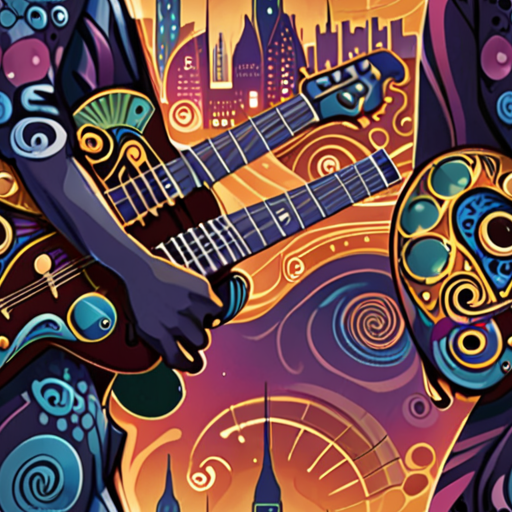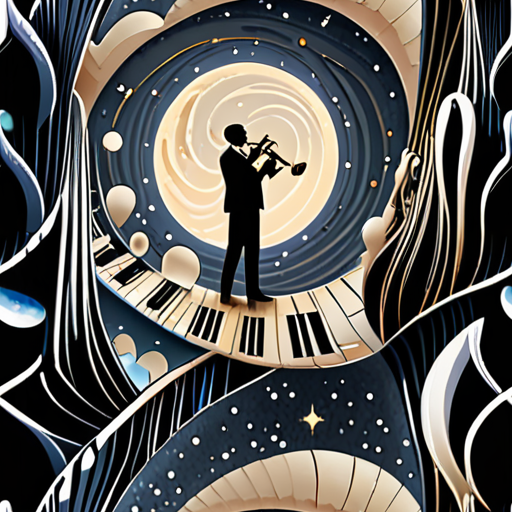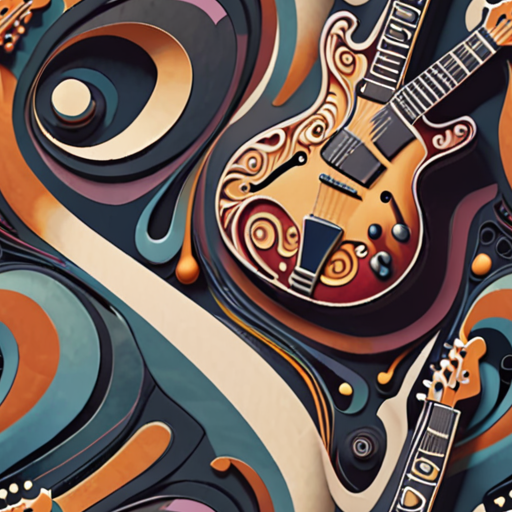For musicians seeking to push the boundaries of traditional jazz, jazz fusion music lessons offer a unique opportunity to explore complex harmonies and rhythms. This innovative approach combines elements of jazz, rock, funk, and other styles to create a distinctive sound that challenges even the most skilled players. By mastering the jazz fusion method, musicians can unlock new levels of creativity and expression, but it requires dedication, practice, and a willingness to experiment with different techniques.

The Jazz Fusion Method
Jazz fusion arrangements vary in complexity, ranging from simple, repetitive melodies to intricate chord progressions and unconventional time signatures.
- Sometimes, jazz fusion employs groove-based vamps fixed to a single key or a single chord, often accompanied by a simple, repeated melody.
- Other times, it uses elaborate chord progressions, countermelodies, and complex rhythmic patterns to create a unique sound.
- This blend of jazz and rock/funk influences has led to the development of various sub-genres, each with its own distinct characteristics and styles.
Some notable examples of jazz fusion artists include Miles Davis, Herbie Hancock, and Weather Report, who have all pushed the boundaries of traditional jazz and created new sounds through their innovative approaches to composition and improvisation.
Key Elements of the Jazz Fusion Method
- Experimentation with unusual time signatures and polyrhythms
- Blending of jazz harmonies with rock and funk influences
- Emphasis on improvisation and spontaneity
- Use of electronic instruments and effects processing
Notable Jazz Fusion Artists
- Miles Davis – Known for his work on albums such as “Bitches Brew” and “A Tribute to Jack Johnson”
- Herbie Hancock – Famous for his contributions to jazz fusion on albums like “Head Hunters” and “Thrust”
- Weather Report – A pioneering jazz fusion band known for their eclectic sound and virtuosic musicianship
These artists, along with many others, have helped shape the sound of jazz fusion and continue to influence contemporary music today.
Why Was Jazz Fusion Controversial?
Jazz fusion was a genre that emerged in the late 1960s and early 1970s, characterized by its blend of jazz, rock, and electronic music elements.
- The controversy surrounding jazz fusion stemmed from its departure from traditional jazz forms and its adoption of elements from other genres, such as rock and electronic music.
- Jazz purists saw jazz fusion as a watered-down version of true jazz, lacking the complexity and sophistication of earlier jazz styles.
- Others criticized jazz fusion for its emphasis on technical virtuosity and showmanship, which they felt detracted from the emotional intensity and spontaneity of traditional jazz.
Despite these criticisms, jazz fusion continued to evolve and gain popularity throughout the 1970s and beyond, influencing a wide range of musical genres and artists.
Key Factors Contributing to the Controversy
- Lack of Traditional Jazz Roots: Many critics felt that jazz fusion lacked the deep roots in traditional jazz that had defined earlier styles, leading to accusations of superficiality and lack of authenticity.
- Emphasis on Technical Virtuosity: The increasing emphasis on technical virtuosity and showmanship in jazz fusion led some critics to accuse the genre of prioritizing style over substance.
- Blending of Genres: The blending of jazz with elements from other genres, such as rock and electronic music, raised questions about the identity and integrity of the jazz tradition.
Impact on the Music Industry
Jazz fusion had a significant impact on the music industry, paving the way for future fusions of jazz with other genres and inspiring a new generation of musicians to experiment with innovative sounds and styles.
Legacy of Jazz Fusion
Today, jazz fusion is recognized as a vital and influential genre that helped shape the course of popular music in the latter half of the 20th century.
Tiger Funk celebrates the rich history and cultural significance of funk, soul, and jazz fusion music through in-depth articles, artist profiles, album reviews, and historical retrospectives.
For more information on jazz fusion and its legacy, visit our website at https://tigerfunk.com/ .
Other notable platforms that explore the world of jazz fusion include AllMusic and JazzTimes .

Whats the Difference Between Jazz and Jazz Fusion?
Jazz fusion is a genre that combines elements of jazz with other styles, often incorporating rock, funk, or hip-hop influences. At its core, jazz remains the foundation, but the incorporation of external styles creates a unique sound. To understand the distinction, let’s explore the characteristics of each genre.
- Jazz:
- A genre characterized by improvisation, syncopated rhythms, and melodic complexity.
- Origins in African-American communities in the southern United States during the late 19th and early 20th centuries.
- Evolved through various sub-genres, including swing, bebop, Latin jazz, and free jazz.
- Jazz Fusion:
- A genre that emerged in the late 1960s and 1970s, blending jazz with elements of rock, funk, and electronic music.
- Characterized by complex time signatures, extended instrumental solos, and a strong emphasis on rhythm.
- Influenced by artists such as Miles Davis, Herbie Hancock, and Weather Report, who pushed the boundaries of traditional jazz.
- Sound: Jazz fusion often features a more aggressive, driving sound, whereas traditional jazz tends to be more subdued and introspective.
- Structure: Jazz fusion frequently employs non-traditional song structures, incorporating elements of rock and funk, whereas traditional jazz typically adheres to established forms.
- Instrumentation: Jazz fusion often incorporates electric instruments, synthesizers, and drum machines, whereas traditional jazz relies on acoustic instruments.
- Miles Davis – A pioneer of jazz fusion, known for his work on albums such as “Bitches Brew” and “A Tribute to Jack Johnson.”
- Herbie Hancock – A versatile pianist and composer who has explored various styles, including jazz fusion, on albums like “Head Hunters” and “Maiden Voyage.”
- Weather Report – A jazz fusion band formed by Joe Zawinul and Wayne Shorter, known for their innovative blend of jazz, rock, and world music.
Main Differences:
Notable Artists:
Conclusion:
While jazz and jazz fusion share a common foundation, the latter genre represents a distinct evolution, incorporating external influences to create a unique sound. By understanding the differences between these two genres, we can appreciate the diversity and innovation that has shaped the world of jazz music.

Is Jazz Fusion Guitar Hard?
Becoming a jazz-rock fusion guitarist is a lifelong process, but many aspiring musicians find it challenging due to the genre’s unique blend of modern jazz complexity and rock bravado.
- The difficulty lies in mastering the intricate chord progressions, complex time signatures, and improvisational techniques characteristic of jazz fusion.
- Jazz fusion guitarists must possess a strong foundation in both jazz and rock music theory, as well as advanced technical skills, including fingerstyle technique and effects processing.
- The genre’s eclecticism can also make it difficult to pinpoint a specific style or sound, leading to confusion among beginners.
However, with dedication and persistence, anyone can learn to play jazz fusion guitar. Here are some tips to help you get started:
- Develop a strong musical foundation**: Learn the basics of jazz and rock music theory, including chord progressions, scales, and arpeggios.
- Practice advanced techniques**: Focus on developing fingerstyle technique, legato playing, and advanced effects processing.
- Listen to and study jazz fusion masters**: Analyze the playing styles and techniques of legendary jazz fusion guitarists, such as Pat Metheny, John McLaughlin, and Al Di Meola.
- Join a community of like-minded musicians**: Connect with other jazz fusion enthusiasts through online forums, social media groups, or local music schools.
Remember, learning jazz fusion guitar takes time, patience, and dedication. With consistent practice and a willingness to challenge yourself, you can develop the skills necessary to become a proficient jazz fusion guitarist.
Tiger Funk is a great resource for learning more about jazz fusion music and finding inspiration from talented artists who have mastered the genre.
What is the Hardest Jazz Instrument to Learn?
The world of jazz is filled with complex rhythms, intricate melodies, and a wide variety of instruments, making it a challenging genre to master.
- The saxophone, with its smooth, soulful sound, can be difficult to learn due to its fingerings and embouchure requirements.
- The piano, often considered the backbone of jazz, demands a high level of technical skill, including hand independence, finger dexterity, and harmonic understanding.
- The guitar, whether acoustic or electric, requires a strong foundation in chord progressions, scales, and arpeggios, as well as the ability to navigate complex fingerpicking patterns.
- The bass, with its melodic and rhythmic responsibilities, necessitates a deep understanding of harmony, rhythm, and phrasing.
However, among these instruments, the trumpet stands out as particularly demanding due to its unique combination of technical and musical challenges.
- Fingerings: The trumpet has a relatively small number of keys, which means that even slight changes in finger placement can significantly affect pitch and tone.
- Embouchure: Developing a consistent, comfortable embouchure (the position and shape of the lips, facial muscles, and jaw) is crucial for producing a clear, resonant sound.
- Intonation: Achieving precise intonation on the trumpet requires a high degree of ear training and control over breath support, air stream direction, and lip tension.
- Technical facility: Trumpet players need to develop advanced technical skills, including rapid articulation, dynamic control, and expressive phrasing.
While mastering the trumpet takes dedication and perseverance, many musicians find the rewards of playing this instrument well worth the effort.
At Tiger Funk, we believe that every musician deserves access to high-quality educational resources and community support, regardless of their chosen instrument or level of expertise.
Whether you’re just starting out or looking to refine your skills, we invite you to explore our website and discover the wealth of knowledge and inspiration available to you.

What is the Hardest Style to Play on Guitar?
The hardest style to play on guitar is often subjective and can vary depending on individual skill levels and musical backgrounds.
- Fingerstyle Techniques
- Classical Guitars
- Baroque Music
- Flamenco Music
Fingerstyle playing involves plucking the strings individually with the fingers, creating intricate melodies and harmonies.
This technique requires a high level of dexterity, coordination, and control, making it challenging for many guitarists.
Classical guitars have a unique sound and playing style that demands precision and delicacy.
The nylon strings and wider neck of classical guitars require a distinct approach to finger placement and picking, which can be difficult to master.
Baroque music, characterized by complex harmonies and ornaments, presents a significant challenge for guitarists.
The intricate fingerwork and nuanced phrasing required to execute Baroque pieces accurately can be daunting, even for experienced players.
Flamenco music, originating from Spain, is known for its passionate and expressive playing style.
The rapid-fire strumming and intricate hand movements demanded by flamenco music require exceptional technical skill and emotional intensity.
In conclusion, while opinions may vary, fingerstyle techniques, classical guitars, Baroque music, and flamenco music are generally considered among the most challenging styles to play on guitar.

0 Comments